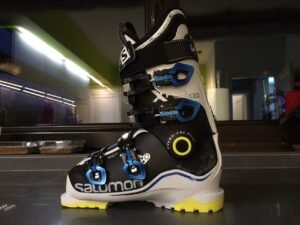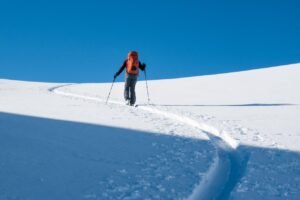You can comfortably carry all your gear and essentials while hitting the slopes. When choosing a bag for skiing, it’s important to consider the type of skiing you’ll be doing, the duration of your outings, and the gear you need to carry. Here are some guidelines to help you select the right bag:
Types of Ski Bags
Ski Boot Bags:
- Purpose: Specifically designed to carry ski boots, with compartments for additional gear.
- Features: Separate compartments for boots, waterproof base, ventilated areas, padded shoulder straps, additional pockets for accessories.

Ski Bags (for skis and poles):
- Purpose: To carry and protect your skis and poles during transport.
- Features: Padded interiors, adjustable lengths, reinforced straps, wheels for easy transport.
Backpacks (for on-slope use):
- Purpose: To carry essentials while skiing, such as water, snacks, extra layers, and safety gear.
- Features: Hydration system compatibility, ski/snowboard carry system, avalanche gear compartments, padded back panel and shoulder straps, waist and sternum straps for stability.

Key Features to Consider
Capacity:
- Day Trips: A small to medium-sized backpack (15-30 liters) for essentials like water, snacks, and an extra layer.
- Backcountry or Longer Trips: A larger backpack (30-50 liters or more) to accommodate additional gear like avalanche equipment, extra clothing, and food.
Durability and Material:
- Look for bags made from high-quality, durable materials like ripstop nylon or polyester.
- Waterproof or water-resistant materials are essential to keep your gear dry.
Comfort and Fit:
- Padded and adjustable shoulder straps, back panel, and waist belt for comfort and even weight distribution.
- Consider the bag’s fit, especially for longer excursions, to prevent strain and discomfort.
Organization and Access:
- Multiple compartments and pockets for organized storage.
- Easy access to main compartments, especially for avalanche gear in backcountry packs.
- Dedicated pockets for specific items like goggles, helmet, and hydration system.
Ski/Snowboard Carry System:
- Options to carry skis diagonally or in an A-frame, or to carry a snowboard vertically or horizontally.
- Secure straps and reinforcements to keep your equipment stable and secure.
Additional Features:
- Helmet carry system to keep your helmet secure when not in use.
- Hydration compatibility with a sleeve for a hydration bladder and a port for the drinking tube.
- Insulated hydration tube sleeve to prevent freezing in cold temperatures.
- Safety features like a whistle on the sternum strap and reflective elements.

Recommendations
For Resort Skiing:
- A small to medium-sized backpack (15-25 liters) with hydration compatibility and enough space for essentials.
- Example: CamelBak Snoblast, Dakine Heli Pro.
For Backcountry Skiing:
- A larger backpack (30-50 liters) with dedicated avalanche gear compartments, ski carry options, and ample storage.
- Example: Osprey Kamber/Kresta series, Black Diamond Dawn Patrol.
For Travel:
- A padded ski bag with wheels for easy transport and a ski boot bag with separate compartments.
- Example: Dakine Fall Line Ski Roller Bag, Athalon Everything Boot Bag.
Some Other Bags You May need for Skiing:
Ski Duffel Bag:
A spacious and versatile option for transporting larger items such as ski jackets, pants, base layers, and other bulky gear.
Look for a ski duffel bag with durable construction, reinforced handles, and multiple compartments for easy organization.
Ski Travel Bag:
Designed for transporting skis, poles, and other equipment when traveling to and from the ski resort.
Choose a ski travel bag with padded lining, compression straps, and wheels for easy maneuverability through airports and train stations.
Helmet Bag:
Specifically designed to protect and transport ski helmets safely.
Look for a helmet bag with padded lining, ventilation panels, and adjustable straps for a secure and comfortable fit.
Goggle Case:
Protects ski goggles from scratches, impacts, and damage during transport.
Choose a goggle case with a soft, padded interior and a hard-shell exterior for maximum protection.
Waterproof Bag:
Essential for keeping items dry and protected from snow, moisture, and wet conditions.
Look for waterproof bags made of durable materials like PVC or nylon, with sealed seams and water-resistant zippers.
Ski Equipment Bag Set:
A convenient option that includes multiple bags designed for different types of ski equipment.
Look for sets that include a ski boot bag, ski backpack, and additional storage bags for helmets, goggles, and clothing.
Insulated Cooler Bag:
Keeps food and drinks cold while skiing or during breaks on the mountain.
Choose an insulated cooler bag with sufficient capacity, durable insulation, and adjustable straps for easy carrying.
Personalized Gear Bag:
Consider customizing or personalizing your ski bag to make it easily identifiable and reflect your style and personality.
When selecting a bag for skiing, consider factors such as size, capacity, durability, and functionality to ensure it meets your specific needs and preferences. Invest in high-quality bags that can withstand the rigors of skiing and provide reliable protection for your gear in all conditions.

